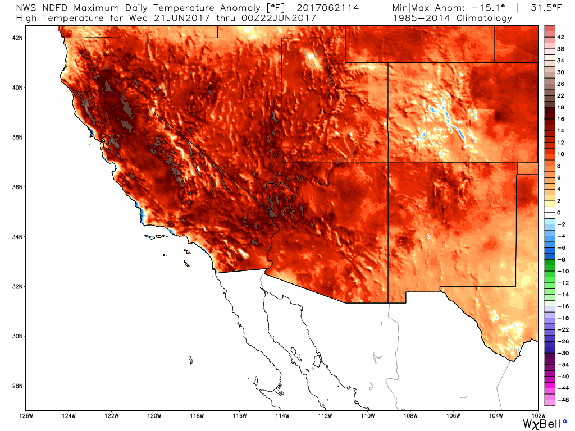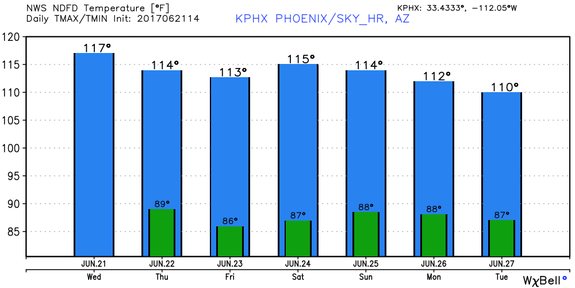Brutal Southwest U.S. heat wave sends temperature soaring to 125 degrees

There is little that's normal about the heat wave roasting the Southwest U.S. during the past several days. In Phoenix and Palm Springs, temperatures were so high that 43 flights on American Eagle's regional jets were canceled on Tuesday afternoon because the heat exceeded aircraft operating limits.
So far, slightly lower temperatures are expected on Wednesday, and there were no heat-related delays or cancelations as of Wednesday morning, American Airlines said in an email.
The reason for the flight cancelations is that the heat plus the relatively high altitudes in the Southwest caused the air to be so thin that it was impossible for small jets' wings to generate enough lift to become safely airborne. Since Sunday, more than 100 flights were canceled due to the heat, according to American Airlines and news reports.
SEE ALSO: It's so hot in the Southwest U.S. that some planes can't take off
Flights operated by larger jets, such as Boeing 737s and Airbus A320s, were not affected, although rides in and out of Phoenix, Palm Springs and Las Vegas were more turbulent than usual because of the extremely hot air, which rises in pockets known as thermals, jostling passengers as planes fly through them.
The heat wave's severity, geographical scope, and duration are all unusual in the context of the past several decades at least, and studies show this is the type of event that is becoming more likely and severe due in part to human-caused global warming.

Image: weatherbell analytics/nws.
On Tuesday, the temperature in Phoenix hit 119 degrees Fahrenheit, which was the fourth-highest temperature on record there.
Another way to put this is that out of 11,060 days since summer records began in Phoenix in 1896, the city has only seen 16 days with a high temperature of 118 degrees Fahrenheit or higher, including Tuesday. Notably, all but one of these days have been since 1989, according to the National Weather Service (NWS).
Yuma, Arizona, also recorded its fourth-highest temperature on record, at 120 degrees Fahrenheit, a level also reached in June of last year. The hottest temperature ever recorded in Phoenix since records began there in 1896 was 122 degrees.
In Tucson, Arizona, the high temperature on Tuesday hit 116 degrees, which was dangerously hot, but it was actually the overnight minimum temperature that set a record there.
Needles, CA also tied an *ALL-Time* record high today with a toasty 125 degrees! #cawx
— NWS Las Vegas (@NWSVegas) June 21, 2017
On Tuesday morning, the temperature in Tucson only fell to 86 degrees Fahrenheit, which was six degrees above the days' high temperature in New York City, for comparison. This goes down as the warmest June low temperature on record in the Arizona desert city, according to the NWS.
Because the day's minimum temperature was so high and the high temperature was scorching, too, the daily average temperature hit a new record there, with a reading of 102 degrees. This was the first time Tucson has ever seen a triple digit average daily temperature. Based on climate trends, it won't be the last.
Record highs were also set or tied in Palm Springs and Thermal, California, and on Wednesday, excessive heat warnings and other high temperature advisories were issued for nearly the entire state of California, in addition to all of Arizona, as well as parts of Nevada and New Mexico.

Image: weatherbell analytics/nws
Needles, California, which is one of the country's warmest locations in the desert along Interstate 40 between Arizona and Los Angeles, tied its all-time high temperature record of 125 degrees Fahrenheit on Tuesday, according to the NWS. This is Middle-East-like heat.
Computer models project that the heat wave will persist in many areas all the way through the weekend and into next week, which means that some locations could make a run at all-time heat wave duration records. In Phoenix, forecast high temperatures are predicted to remain above 110 degrees Fahrenheit through Tuesday, June 27.
Even Silicon Valley is expected to get in on the hot weather on Wednesday and Thursday, with high temperatures in the San Jose area expected to reach close to 100 degrees Fahrenheit. Various heat advisories and warnings are even in effect for parts of San Francisco, with a forecast high at San Francisco International Airport of 90 degrees on Thursday.
When heat is so unrelenting, the public health impacts can become more serious, particularly for anyone without regular access to air conditioning.
Scientists: Expect more heat waves like this
The proximate cause of this heat wave is a massive area of high pressure, also referred to as a heat dome, that extends from the Southwest into the Northeast Pacific Ocean. This is effectively putting a lid on the atmosphere, preventing organized areas of precipitation from forming and providing much-needed heat relief.
When they become stuck in place for a week or more at a time, as this one is likely to do, such weather patterns can cause long-lasting, potentially deadly heat events.
Some studies have shown that the likelihood of such slow-moving weather patterns is growing as climate change melts Arctic sea ice and sets in motion changes in the jet stream, which helps steer weather systems in the Northern Hemisphere. However, much of this research is still emerging.
What is more firmly established, however, is that heat waves are one of the most certain impacts of human-caused global warming, since as average temperatures increase, the likelihood of heat extremes jumps even more. Studies have shown a sharply increased risk of these events as ocean and surface temperatures climb.
While some parts of the world are more vulnerable to heat extremes than others, in the U.S., the fastest warming states since 1970 have been New Mexico and Arizona, both of which are at the epicenter of the ongoing event.

Image: Climate Central
In April, researchers reported that in addition to making extreme weather events more likely throughout the world, climate change is also making such events more severe. By midcentury, what is considered extreme heat now will be more common in many places across the U.S.
Using weather observations and a group of climate models known as an ensemble, the researchers from Stanford University and the University of California at Los Angeles found that the warming-to-date has already increased the severity and probability of the hottest month and hottest day of the year at more than 80 percent of weather observing sites.

Image: Climate Central

Image: climate central
“Heat waves tend to have a very clear signature in the atmospheric conditions that cause them. Our research has shown that as global warming has unfolded, those atmospheric conditions have progressively been causing more and more widespread occurrences of extreme heat," said Noah Diffenbaugh, a climate scientist at Stanford University and lead author of the study.
"Our research has also shown that global warming has already had a fingerprint on the hottest days of the year," he said.
As global warming continues, it's becoming easier for locations to set all-time records, particularly temperature records, because the baseline climate is shifting so significantly and quickly.
This is similar to a basketball game in which the floor is steadily rising, making it easier for players to dunk the ball.
